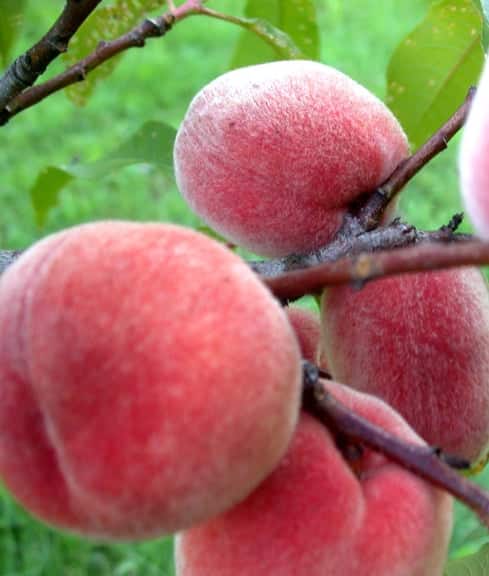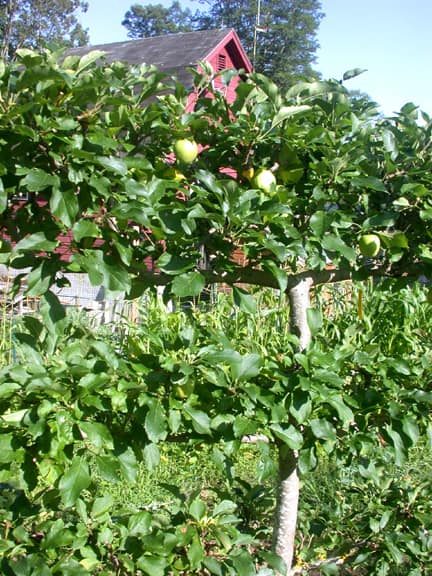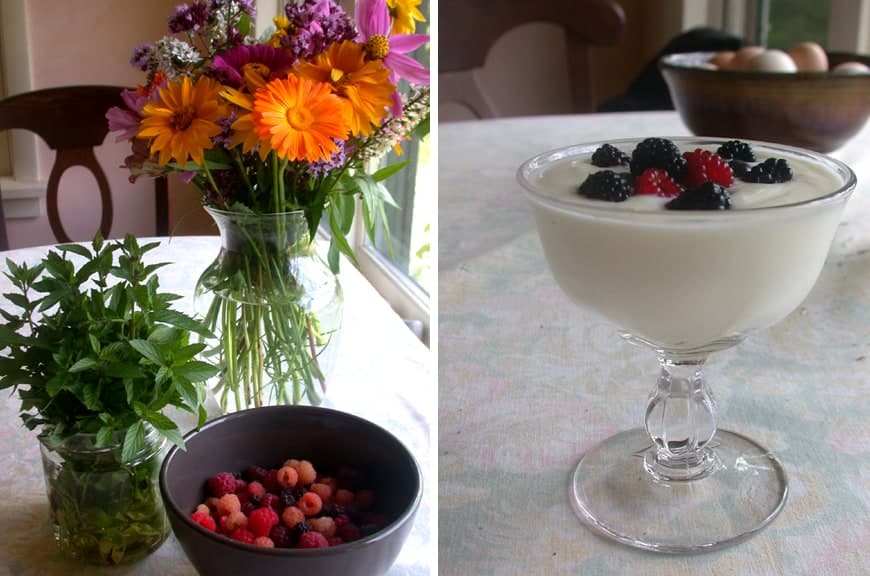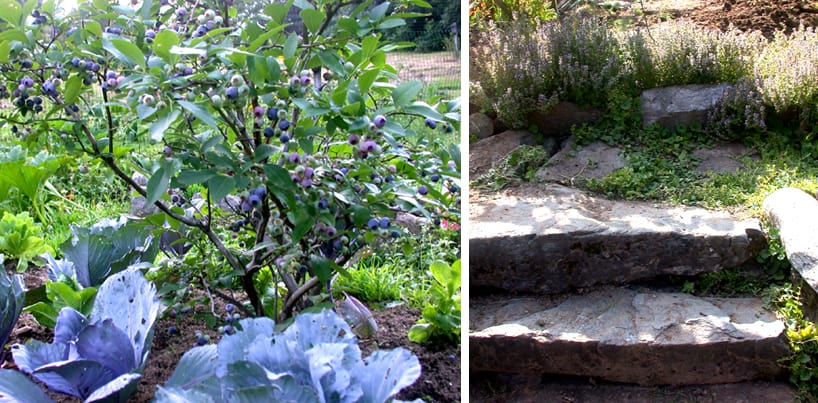Photos and text by Erica Bowman, JMMDS
These uncertain times have everyone scrambling for a safe place to put their money. My hot investing tip? Perennial edible plants. Investments of the perennial edible variety are likely to be repaid in full, in yearly installments of fruit, not cash dividends. Just as with a venture into solar panels or a hybrid car, the return is likely to be slow but steady, with a bottom-line emphasis on social responsibility and environmental stability with the delicious extra perk of satisfying self-reliance.

Want to see more green? Try red…or gold…or purple!
Some investments in edible perennials, especially fruit trees, are expensive (and there are varieties that require two plants for proper pollination). The rewards can be substantial, however. Our neighbor’s bountiful apple and blueberry orchard was originally planted by his father over sixty years ago and is still producing huge quantities of fruit.

What could be more pleasing to the senses than ripe peaches? Fruit trees are among the most rewarding long-term investments a gardener can make.
At our homestead, Evernest, our harvest begins in early March with the annual boiling of the maple sap. May brings the asparagus crop, wintercress, and a prolific edible weed, wood sorrel. By late June our asparagus is joined by strawberries, mints, oreganos, and thyme. In early July our black and red raspberries begin, and by late July the blueberries chime in. In August the blackberries, apples, pears, grapes, and peaches start to ripen. The apples are spread out by cultivar and last until frost. What we save on our food bill and gain in health and enjoyment is well worth the initial outlay.

Espaliering is a method of training a tree that is not only decorative but helps manage the shade cast by the tree, so other nearby plants get more sun.
Make sure to include your perennial edible plants in a Master Plan of your whole property. A semi-dwarf apple tree, for example, has as much physical presence as a Kousa dogwood and should be given as much aesthetic weight in the overall design. The espaliered apple tree pictured above lends a beautiful design element as well as delicious fruit.
How to Make the Most of Your Investment
It is essential to select plants according to your site conditions, not just your palate. Blueberries, for example, require acidic soil. Black raspberries prefer partial shade. Pear trees need sun. Wintercress needs a constant source of water.
The importance of proper preparation of the soil or planting bed should not be underestimated. Asparagus plants need deep friable soil 2-3’ down to succeed. Raspberries prefer moist, fertile soil and need strict, enforceable boundaries (or they will take over). Grapes need a growing structure to support their vines. It’s necessary to wait until you have taken care of this preparation before getting the plants.

Sweet dividends: peppermint, flowers (including beautiful and tasty white garlic chives), raspberries for my morning yogurt, and a bounty of fresh eggs.
It is also important to develop your approach to weed and pest control before planting. Plants of the rose family (apples, plums, strawberries, cherries, raspberries, etc.) tend to be susceptible to a host of pests and diseases. This is why most conventional farmers use pesticides. At Evernest, we forgo all conventional pesticides and as a result can sometimes have spots on our apples, Japanese beetles on our raspberries, and slugs on our strawberries; we also lose a tree from time to time. We prefer these minor losses to pesticide residue.
Perennial edibles attract wildlife. Bears, for instance, love blueberries. They will also eat blackberries, apples, and whatever other fruit your garden has to offer. Birds will gladly swoop down and collect your prize raspberries. I have seen my chickens doing their best to launch their stout bodies upwards and snag fruit off of the vine. At Evernest we seem to have enough to go around, but some gardeners will want to take precautions to protect their harvest.

Perennial edibles can provide a frame for your annual vegetable garden, or they can be used for their ornamental qualities throughout the gardenscape. L: The complementary blues of annual cabbages and perennial blueberries. R: Creeping thyme and creeping Jenny soften stonework.
Finally, healthy fruiting plants may provide you with a cornucopia of fruit, the likes of which you have never seen. Not wanting to let an overabundance of fruit rot on the ground, I find myself making vats of applesauce, canning twelve-packs of pears, and filling the freezer with blueberries. You can also share with neighbors, and in the case of true excess call your local gleaning operation.
Consider adding more edible perennials to your planting portfolio. In the meantime, here is a tart recipe that will use up a couple of pints of berries and several excess eggs and put a smile on a host of faces. Now, that’s a satisfying dividend.






I’m moving to and investing in Evernest!!!! Wonderful post Myrica!!!!
Erica, I always enjoy your posts! This article inspired me to spend my weekend catching up on harvesting veggies and herbs, making pickles, and poaching peaches (with cognac…mmm). It also gives me some good ideas for perennial edible plants to add next year…wintercress is a must!
I recommend that you remain mindful of seasonal flooding and its effect on your “investment.” We live in rural Michigan (Allegan County) in a community that has not had standing water for over 75 years (so the old timers tell us.) We have now had serious spring flooding for the past four years. We have lost our raspberries and all of our apple and peach orchard (as well as everything on the floor in our large pole barn (basements here are flooded and ruined.) The county has a plan for a drain extention (i.e ditches, culverts and pipes under driveways and roads to channel the excess water to the nearby wetlands and lakes) but the engineer firm handling this tells us we are in the wettest part of the 100 year wet cycle and to expect water for 3 to 6 more years. BE AWARE!
I recommend that you remain mindful of seasonal flooding and its effect on your “investment.” We live in rural Michigan (Allegan County) in a community that has not had standing water for over 75 years (so the old timers tell us.) We have now had serious spring flooding for the past four years. We have lost our raspberries and all of our apple and peach orchard (as well as everything on the floor in our large pole barn (basements here are flooded and ruined.) The county has a plan for a drain extention (i.e ditches, culverts and pipes under driveways and roads to channel the excess water to the nearby wetlands and lakes) but the engineer firm handling this tells us we are in the wettest part of the 100 year wet cycle and to expect water for 3 to 6 more years. BE AWARE!
Thanks for your comment, Donna. We are sorry for your heartbreaking loss–the work lost and the damage to your property. It’s true that farming is a risky endeavor, all the more so with climate change occurring in real time right in our own yards. Good luck to you.